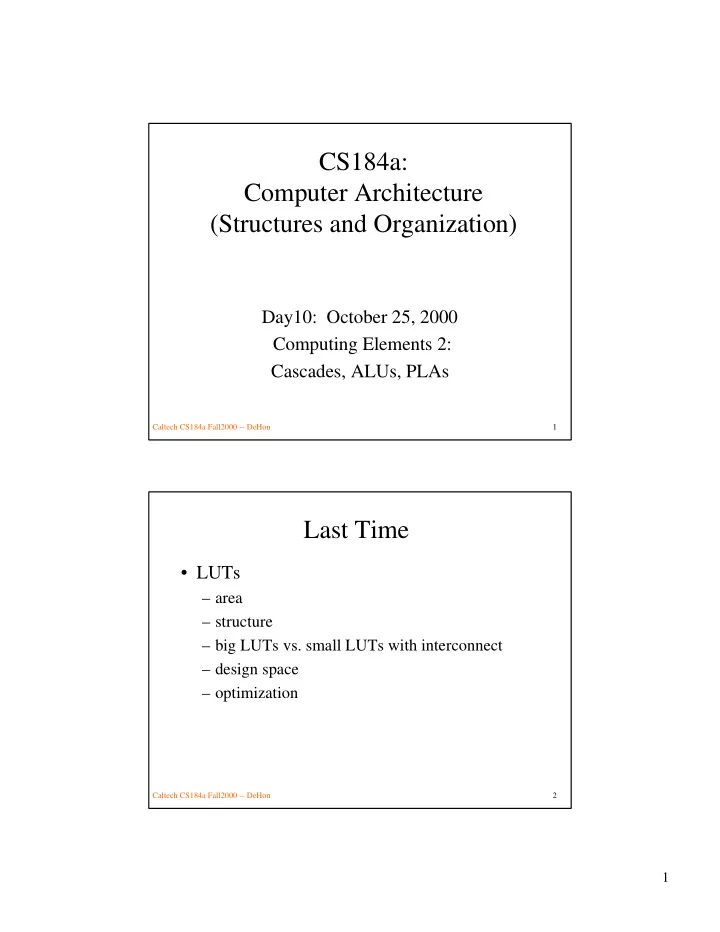

CS184a: Computer Architecture (Structures and Organization) Day10: October 25, 2000 Computing Elements 2: Cascades, ALUs, PLAs Caltech CS184a Fall2000 -- DeHon 1 Last Time • LUTs – area – structure – big LUTs vs. small LUTs with interconnect – design space – optimization Caltech CS184a Fall2000 -- DeHon 2 1
Today • LUT Delay • LUT Cascades • ALUs • PLAs Caltech CS184a Fall2000 -- DeHon 3 Delay Caltech CS184a Fall2000 -- DeHon 4 2
Delay? • Circuit Depth in LUTs? • “Simple Function” --> M-input AND – 1 table lookup in M-LUT – log k (M) in K-LUT Caltech CS184a Fall2000 -- DeHon 5 Delay? • M-input “Complex” function – 1 table lookup for M-LUT – between: (M-K)/log 2 (k) +1 – and (M-K)/log 2 (k- log 2 (k)) +1 Caltech CS184a Fall2000 -- DeHon 6 3
Delay • Simple: log M • Complex: linear in M • Both go as 1/log(k) Caltech CS184a Fall2000 -- DeHon 7 Circuit Depth vs. K Caltech CS184a Fall2000 -- DeHon 8 4
LUT Delay vs. K • For small LUTs: • Large LUTs: – t LUT ≈ c 0 +c 1 × K – add length term – c 2 ×√ 2 K • Plus Wire Delay – ~ √ area Caltech CS184a Fall2000 -- DeHon 9 Delay vs. K Why not satisfied with this model? Delay = Depth × (t LUT + t Interconnect ) Caltech CS184a Fall2000 -- DeHon 10 5
Observation • General interconnect is expensive • “Larger” logic blocks – => less interconnect crossing – => lower interconnect delay – => get larger – => get slower • faster than modeled here due to area – => less area efficient • don’t match structure in computation Caltech CS184a Fall2000 -- DeHon 11 Different Structure • How can we have “larger” compute nodes (less general interconnect) without paying huge area penalty of large LUTs? Caltech CS184a Fall2000 -- DeHon 12 6
Structure in subgraphs • Small LUTs capture structure • Structure of small LUT-mapped netlists? Caltech CS184a Fall2000 -- DeHon 13 Structure • LUT sequences ubiquitous Caltech CS184a Fall2000 -- DeHon 14 7
Hardwired Logic Blocks Single Output Caltech CS184a Fall2000 -- DeHon 15 Hardwired Logic Blocks Two outputs Caltech CS184a Fall2000 -- DeHon 16 8
Relation to ALUs • How do ALUs differ? Caltech CS184a Fall2000 -- DeHon 17 PLAs Caltech CS184a Fall2000 -- DeHon 18 9
PLA Caltech CS184a Fall2000 -- DeHon 19 PLA and Memory Caltech CS184a Fall2000 -- DeHon 20 10
PLA and PAL Caltech CS184a Fall2000 -- DeHon 21 PLAs • Fast Implementations for large ANDs or Ors • Number of P-terms can be exponential in number of input bits – most complicated functions • Can use arrays of small PLAs – to exploit structure – like we saw arrays of small memories last time Caltech CS184a Fall2000 -- DeHon 22 11
PLAs vs. LUTs? • Look at Inputs, Outputs, P-Terms – minimum area (one study, see paper) – K=10, N=12, M=3 • A(PLA 10,12,3) comparable to 4-LUT? – 80-130%? – 300% on ECC (structure LUT can exploit) • Delay? – Claim 40% fewer logic levels • (general interconnect crossings) Caltech CS184a Fall2000 -- DeHon 23 PLA Optimization (Folding) Caltech CS184a Fall2000 -- DeHon 24 12
Conventional/Commercial FPGA Altera 9K (from databook) Caltech CS184a Fall2000 -- DeHon 25 Conventional/Commercial FPGA Altera 9K (from databook) Caltech CS184a Fall2000 -- DeHon 26 13
Finishing Up... Caltech CS184a Fall2000 -- DeHon 27 Admin • Homework 2 return • Questions about homework Caltech CS184a Fall2000 -- DeHon 28 14
Big Ideas [MSB Ideas] • Programmable Interconnect allows us to exploit that structure – want to match to application structure • Hardwired Cascades – key technique to reducing delay in programmables • PLAs – canonical two level structure – hardwire portions to get Memories, PALs Caltech CS184a Fall2000 -- DeHon 29 Big Ideas [MSB-1 Ideas] • Delay – LUT depth decreases with K • in practice closer to log(K) – Delay increases with K • small K linear + large fixed term • minimum around 5-6 • Better structure match with hardwired LUT cascades Caltech CS184a Fall2000 -- DeHon 30 15
Recommend
More recommend